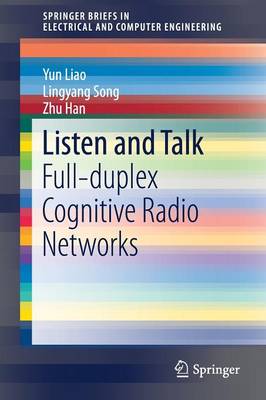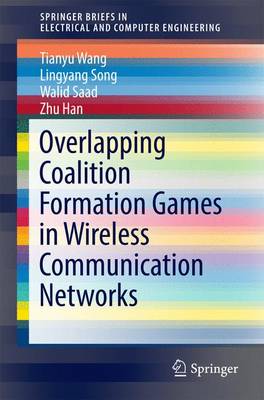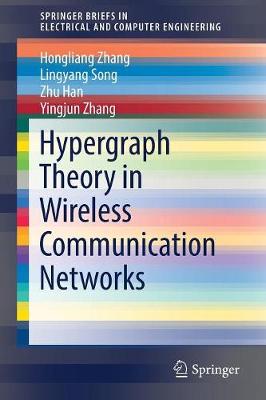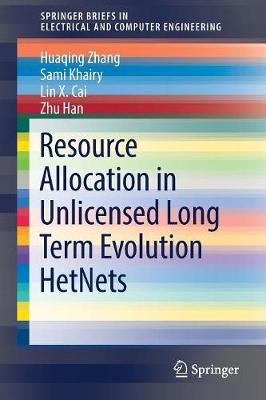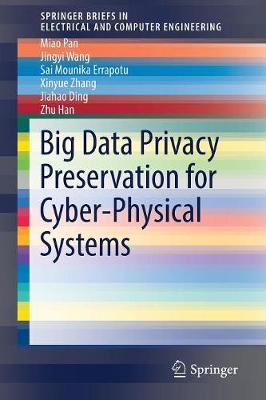SpringerBriefs in Electrical and Computer Engineering
5 total works
Listen and Talk: Full-duplex Cognitive Radio Networks is designed for researchers, developers, and professionals involved in cognitive radio networks. Advanced-level students studying signal processing or simulations will also find the content helpful since it moves beyond traditional cognitive radio networks into future applications for the technology.
Overlapping Coalition Formation Games in Wireless Communication Networks
by Tianyu Wang, Lingyang Song, Walid Saad, and Zhu Han
This brief introduces overlapping coalition formation games (OCF games), a novel mathematical framework from cooperative game theory that can be used to model, design and analyze cooperative scenarios in future wireless communication networks.
The concepts of OCF games are explained, and several algorithmic aspects are studied. In addition, several major application scenarios are discussed. These applications are drawn from a variety of fields that include radio resource allocation in dense wireless networks, cooperative spectrum sensing for cognitive radio networks, and resource management for crowd sourcing. For each application, the use of OCF games is discussed in detail in order to show how this framework can be used to solve relevant wireless networking problems.
Overlapping Coalition Formation Games in Wireless Communication Networks provides researchers, students and practitioners with a concise overview of existing works in this emerging area, exploring the relevant fundamental theories, key techniques, and significant applications.
Hypergraph Theory in Wireless Communication Networks
by Hongliang Zhang, Lingyang Song, Zhu Han, and Yingjun Zhang
This brief focuses on introducing a novel mathematical framework, referred as hypergraph theory, to model and solve the multiple interferer scenarios for future wireless communication networks. First, in Chap. 1, the authors introduce the basic preliminaries of hypergraph theory in general, and develop two hypergraph based polynomial algorithms, i.e., hypergraph coloring and hypergraph clustering. Then, in Chaps. 2 and 3, the authors present two emerging applications of hypergraph coloring and hypergraph clustering in Device-to-Device (D2D) underlay communication networks, respectively, in order to show the advantages of hypergraph theory compared with the traditional graph theory. Finally, in Chap. 4, the authors discuss the limitations of using hypergraph theory in future wireless networks and briefly present some other potential applications.
This brief introduces the state-of-the-art research on the hypergraph theory and its applications in wireless communications. An efficient framework is provided for the researchers, professionals and advanced level students who are interested in the radio resource allocation in the heterogeneous networks to solve the resource allocation and interference management problems.
Resource Allocation in Unlicensed Long Term Evolution HetNets
by Huaqing Zhang, Sami Khairy, Lin X. Cai, and Zhu Han
This SpringerBrief investigates cross layer resource allocation in unlicensed LTE (Long Term Evolution) HetNets. Specifically, the authors study and cover the radio access management of unlicensed LTE to allow efficient spectrum utilization and harmonious coexistence with other unlicensed systems in this brief. Efficient radio access protocols are developed to allow unlicensed LTE users to fair share channel access with unlicensed users in different systems, including Wi-Fi and unlicensed LTE of other operators. An analytical model is developed to study the performance of the proposed protocols.
To achieve efficient spectrum sharing among various unlicensed users, the authors further formulate a resource allocation problem based on Nobel Prize winning game theory framework, and propose efficient algorithms to achieve the maximal user utility. Opportunistic traffic offloading from licensed band to unlicensed bands is also investigated, based on the network formation game. By exploiting the characteristics of mobile social networks, the offloading performance can be further enhanced.
This brief targets researchers and engineers from both academia and industry interested in the development of LTE over unlicensed bands, as well as the design and implementation of cross layer radio resource management. Students studying electrical engineering and computer science will also find this brief useful for their studies.
Big Data Privacy Preservation for Cyber-Physical Systems
by Miao Pan, Jingyi Wang, Sai Mounika Errapotu, Xinyue Zhang, Jiahao Ding, and Zhu Han
This SpringerBrief mainly focuses on effective big data analytics for CPS, and addresses the privacy issues that arise on various CPS applications. The authors develop a series of privacy preserving data analytic and processing methodologies through data driven optimization based on applied cryptographic techniques and differential privacy in this brief. This brief also focuses on effectively integrating the data analysis and data privacy preservation techniques to provide the most desirable solutions for the state-of-the-art CPS with various application-specific requirements.
Cyber-physical systems (CPS) are the "next generation of engineered systems," that integrate computation and networking capabilities to monitor and control entities in the physical world. Multiple domains of CPS typically collect huge amounts of data and rely on it for decision making, where the data may include individual or sensitive information, for e.g., smart metering, intelligent transportation, healthcare, sensor/data aggregation, crowd sensing etc. This brief assists users working in these areas and contributes to the literature by addressing data privacy concerns during collection, computation or big data analysis in these large scale systems. Data breaches result in undesirable loss of privacy for the participants and for the entire system, therefore identifying the vulnerabilities and developing tools to mitigate such concerns is crucial to build high confidence CPS.
This Springerbrief targets professors, professionals and research scientists working in Wireless Communications, Networking, Cyber-Physical Systems and Data Science. Undergraduate and graduate-level students interested in Privacy Preservation of state-of-the-art Wireless Networks and Cyber-Physical Systems will use this Springerbrief as a study guide.
